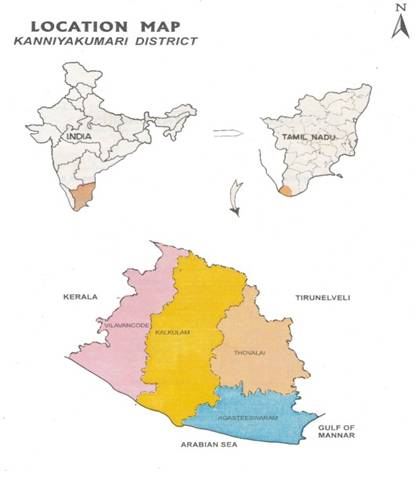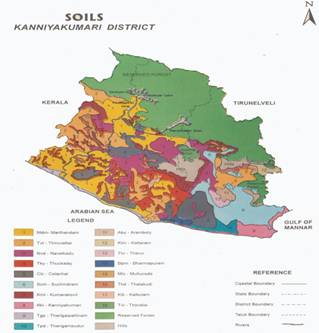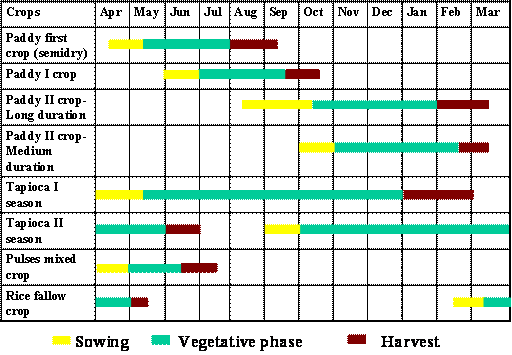Other Links
Welcome to KVK, KANYAKUMARI
Kanyakumari is the southernmost District of Tamil Nadu. The district lies between 77o 15' and 77o 36' of the eastern longitudes and 8o 03' and 8o 35' of the northern Latitudes.
Surrounded by Majestic Hills and the plains bordered by colorful sea-shores, fringed with coconut trees and paddy fields, here and there are few elevated patches of red cliffs with undulating valleys and plains between the mountainous terrain and the sea - coast, so closely interwoven with Temples and Churches and other edifices lies the district, 'Kanyakumari'. (The district name is spelled as ' Kanniyakumari ' in official records which is in tune with the spoken name of the district in Tamil language) . With an area of 1672 sq.km. it occupies 1.29% of the total extent of Tamil Nadu. It ranks first in literacy among other districts in Tamil Nadu.
The District is bound by Tirunelveli District on the North and the east. The South Eastern boundary is the Gulf of Mannar. On the South and the South West, the boundaries are the Indian Ocean and the Arabian Sea. On the West and North West it is bound by Kerala.
Location Map

Agricultural centers
Horticultural Research Station, Pechiparai
It undertakes Research suitable to high rainfall zone. Evaluation of suitable pineapple varieties, tree spices, fruits and vegetables. Standardization of management techniques for Horticultural crops.
Agricultural Research Station, Thirupalthisaram
The object is crop improvement, crop management; and releasing of location specific new varieties of rice suited to Kanyakumari District.
State Seed Farm, Thirupathisaram
The object of the State Seed Farm is to produce foundation and certified classes of paddy seeds to meet the requirement of the farming community. It comprises of 24.02 Ha. with an annual production of 100 M.T. of certified and foundations seeds.
Coconut Nursery (Tall) Puthalam
The object is to produce quality Tall Coconut Seedlings. It is having an area of 1.96 Ha. with an annual production of 51,000 Tall Seedlings.
Coconut Nursery (Tall & Dwarf) Kanyakumari
The object is to produce Tall x Dwarf hybrid coconut seedlings and distribute to the farmers. It occupies an area of 2.44 ha. with an annual production of 26000 TxD hybrid seedlings.
Coconut Crossing Centre (Tall x Dwarf) Agastheeswaram
By using Chowghat Dwarf Orange as male parent hybridization is done on west coast tall coconut trees. The seed nuts are procured and sent to the coconut nursery (TxD) Kanyakumari.
State Horticultural Farm, Pechiparai
The object is to produce fruit and flower plants for distribution to the farming community.
Farmer Training Centre, Thirupathisaram
The Farmers Training Centre is located in Thirupathisaram village 6 Km. Away from Nagercoil. It caters the needs of Kanyakumari District farmers by imparting village level training and demonstrations and improved farming technologies and innovations.
Bio-Control Centre
Parasite Breeding Centre: To produce the parasites Bethelid, Braconid and Eulophid which parasite on Black Headed Caterpillar which infest coconut palms.
Green Muscardines Fungus Production Centre: To produce Green Muscardine fungus which parasitizes and kills the grub of Rhinoceros beetle, the pest that causes heavy damage to coconut palms.
Mushroom Spawn Production Centre: To produce mushroom spawn for composting coir pith and cultivation of edible Mushroom.
Soil and Climate
Soil
Soil Testing Laboratory: To analyse the soil samples collected and sent by the farmers. Mobile Soil Testing Laboratory: The Mobile Soil Testing Laboratory visits the villages and collects samples, analyse and suggest suitable fertilizer recommendations to the farmers on the spot.
Soil Types
S.No |
Soil type |
Characteristics |
Area in ha |
1 |
Lateritic soil |
Reddish brown sandy clay loam |
20033 |
2 |
Red soils |
|
608 |
3 |
Coastal alluvium |
Very pale brown sand |
3830 |
4 |
Alluvium |
Brown sandy clay loam |
1590 |
Soil Classification

Type of Soil |
Places in District |
Agasteeswarem Taluk |
|
Typic Udipoammenta |
Kanyakumari, Agasteeswaram,Thamaraikulam, Dharmapuram, |
Typic Hapludalfs |
Kanyakumari,Thamaraikulam,Kulasekarapuram, Marungoor, Theroor, Eraviputhoor, Suchindram, Parakkai,Thengamputhur, Vadaseri, Kottaram, Azhagappuram |
Typic Underthents |
Kanniyakumari, Agastheeswaram, Kottaram |
Fluventic Dystropepts |
Thamaraikulam, Kulasekarapuram, Theroor, Eraviputhoor, Suchindram, Parakkai, Thengamputhoor, Dharmapuram, Nagercoil, Neendakarai.B, Madusoothanapuram |
Typic Dyssttropepts |
Marungoor, Azhappapuram, Kottaram, Vembanoor |
Udic Rdodudalfs |
Ddharmapuram, Vadasery, Neendakarai.A, Neendakarai.B,Madusuthanapuram |
Udic Hapludalfs |
Dharmapuram, Neendakarai.A, Neendakarai.B |
Aquic Hapludalfs |
Vadiveeswaram, Nagercoil, Vembanoor |
|
|
Kalkulam Taluk |
|
Typic Dystropets |
Kappiarari, Valvachagostam, Attoor, Thuckalay, Kalkulam, Kothanallur, Mecode, Aruvikarai, Thiruvattar, Ponnmanai,Aloor, Eraniel, Thalakulam, Kadiyapattanam, Manavalakurichi, Colachel Town, Colachel, Thiruvithamcode, Viyannoor, Velimalai, Thumpodu, Churulacode, Villukuri, Kuruthencode, Lakshmipuram, Padmanabhapuram Town |
Aquic Hapludalfo |
Kappiarai, Valvachagostam, Thuckalai,Kalkulam, Kothanallor, Thirparappu, Alloor,Eraniel,Thalakulam, Kadiapattinam, Manavalakuichi, Colachel Town, Colachel, Thiruvithamcode,Churulocode, Kurunthencode, Lakshmipuram, Padmanabhapuram Town, |
Udic Ehodudalfs |
Attor,Mecode,Thiruvattar, Thirparappu,Ponmani,Kadiyapattinam, Manavalakurchi, Colachel Town, Colachel, Viyanoor, Churulode, Lakshmipuram, |
Udic Hapludalfe |
Attoor,Thuckalay,Thiruvattur, Ponmani,Aloor,Kadyiapattinam.Velimalai,Thumpodu,Kurunthencode. |
Lithic Udorthents |
Mecode,kadiapattnam,Manavilakuruchi,Colachel Town, Colachel, |
Fluventic Dystripepte |
Lakshimipuram |
Typic Udipsaments |
Colachel Town, Colachel,Lekshmipuram |
|
|
Thovalai Taluk |
|
Typic Dyatyipspts |
Thovalai,Chembagramanputhuoor, Thirupathisaram,Thazhakudy,Annanthapuram, Aralvaimozhi |
Fluvantic Dystropepts |
Thovalai,Chenbagaramanputhoor,Thirupathisaram, Thazhakudi, Azhagiapandipuram,Ananthapuram |
Typic Haplludalfs |
Thovalai,Chenbagaramanputhur,Thirupathisaram, Thazhakudi,Boothapandy,Esanthymangalam, Chiramadum,Derisanamcopu,Arumanaloor, Erachakulam,Aralvaimozhi |
Lithic Usorthents |
Chenbagaramanputhoor, Boothapandy, Eesaanthimangalam,Chiramadam, Derisanamcopu,Azhagiapandipuram,Erachakulam, |
Paralithic Ustorthents |
Esanthimangalam, Cheramadam,Derisanamcopu, Azhagiapandipuram, Erachakulam, |
Hills and forest |
Chiramadam, |
Hills |
Arumanalloor,Erachakulam, |
Udic Hapludalfs |
Thovalai,Derisanamcopu, Arumanalloor, Aralvaimozhi, |
Typic Ustropets |
Aralvoimozhi |
|
|
Vilavancode Taluk |
|
Typic Dystropepts |
Kollancode, Ezhudesam,Painkulam,Arudesam,Methukummal, Kunnathoor, Nalloor, Pacodu, Vilavancode, Palugal, Edaycode, Arumanai, Kalial, Keezhmidalam,Midalam, Keelkulam, Killiyoor, Nattalam, Kulapuram, Anducode, Vellamcode, Mancode, Palloor., |
Udihapludalfs |
Kolemcode, Ezhudesam,Painkulam,Arudesam, Methukummal, Kunnathoor, Nalloor, Kezhmidalam, Killiyoor, Nattalam, Kulapuram, Vellamcode, |
Parlithic Uderthents |
Kollemcode, Ezhudsam, Painkulam,Arudesam, Methukumal, Vilavamcode, Arumanai, Kulapuram,Anducode. |
Auic Hapludalfs |
Kollemcode, Painkulam,Arudesam, Methukummal, Kunathoor, Nalloor, Pacode, Vilavamcode, Palukal, Edaicode, Arumanai, Midalam, Keeezhkulam,Killiyoor, Nattalam, Kulapuram, Anducode, Vellamcode, Mancode, Paluoor |
Udichepludalfs |
Nalloor, Vellamcode, |
Lithic Udorthents |
Nalloor, Vilavancode, Arumanai,Kalial, Anducode, Vellamcode, Mancode. |
Paralithic Dystropepts |
Pacode, Palugal, Edaycode, Kaliyal, Anducode, Moncode, |
Typic |
Arumanai, Velamcode, Mangodu, Kaliyal |
Mallic Dyestopents |
Arumanai, Mangodu,Kalial |
Climate
The District has a favourable agro-climatic condition, which is suitable for growing a number of crops. The proximity of equator, its topography and other climate factors favours the growth of various crops. The paddy varieties grown in the second crop season in Thovalai and Agasteeswaram taluks are grown during the first crop season in Kalkulam and Vilavancode taluks. This shows that there is distinct variation in the climatic conditions prevailing within the district. Unlike other district in Tamil Nadu, it has a rainfall both during the South West and the North East monsoons. The South West monsoon period starts from the month of June and ends in September, While the North East monsoon period starts from October and ends in the middle of December.
Based on the agro-climatic and topographic conditions, the district can be divided into three agro climatic regions, namely:-
- The uplands
Comprising of hills and hill bases suitable for Growing crops like Rubber, Cloves, Nutmeg, Pepper, Pineapple etc. - The Middle
Comprising of plains and valleys fit for growing crops like Paddy, Tapioca, Banana, Coconut etc. - The low lan
Comprising the coastal belt ideal for growing Coconut, Cashew etc.
Cropping Pattern
This District produces paddy, tapioca and oilseeds such as Coconut besides commercial crops like Cashew, Rubber, Fruits and Spices. The important feature of this district is the production of off season Mangoes.
PADDY is the main crop of this district. It is grown in two seasons. First crop is sown in the month of April � June (Kannipoo) and second crop is raised in the month of September � October (Kumbapoo).
TAPIOCA is raised as a subsidiary food crop in this district. The main planting season is April-May. In some pockets, September � October planting is also done as second season crop. It is purely raised as rainfed crop in Kalkulam and Vilvancode taluks and as irrigated crop in some area of Agastheeswaram taluk of this district.
COCONUT is an important cash crop of this district. The main planting season is May to July.
PULSES are raised in rice-fallow and as intercrop in Tapioca. The important pulses are Blackgram, Greengram, Horsegram, Cowpea and Redgram. In the months of April � May and September � October pulses are grown as intercrop with Tapioca. In the months of February � March pulses are raised as pure crop in rice-fallows.
VEGETABLES are cultivated during January � February and July � August. Vegetable is also grown as 3rd crop after the harvest of 2nd crop paddy in some pockets of this district.
BANANA is cultivated mainly during March � May and September - October.
RUBBER is mainly planted in hilly areas of this district. The Govt. rubber plantations and private plantations are given more employment opportunities to the tribals and other weaker sections.
CROP SEQUENCES FOLLOWED IN KANYAKUMARI DISTRICT
- Paddy - Paddy - Fallow (One year rotation)
- Paddy - Paddy - Pulses (One year rotation)
- Paddy - Banana - Paddy (One year rotation)
- Paddy - Banana - Tapioca (One year rotation)
- Paddy - Banana - Banana (One year rotation)
The cropping pattern of Kanyakumari district is given as pictoral representation as below.

